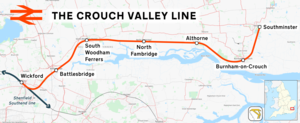Crouch Valley line
| Crouch Valley line | |||
|---|---|---|---|
 Wickford is the western terminus of the line | |||
| Overview | |||
| Status | Operational | ||
| Owner | Network Rail | ||
| Locale | Essex East of England | ||
| Termini | Wickford Southminster | ||
| Stations | 7 | ||
| Service | |||
| Type | Commuter rail | ||
| System | National Rail | ||
| Operator(s) | Greater Anglia | ||
| Rolling stock | Class 321 Class 720 | ||
| History | |||
| Opened | 1889 | ||
| Technical | |||
| Line length | 16 miles 40 chains (26.6 km) | ||
| Number of tracks | 1 | ||
| Character | Rural | ||
| Track gauge | 4 ft 8+1⁄2 in (1,435 mm) standard gauge | ||
| Electrification | 25 kV 50 Hz AC OHLE | ||
| Operating speed | 60 mph maximum | ||
| |||
| Crouch Valley line | ||||||||||||||||||||||||||||||||||||||||||||||||||||||||||||||||||||||||
|---|---|---|---|---|---|---|---|---|---|---|---|---|---|---|---|---|---|---|---|---|---|---|---|---|---|---|---|---|---|---|---|---|---|---|---|---|---|---|---|---|---|---|---|---|---|---|---|---|---|---|---|---|---|---|---|---|---|---|---|---|---|---|---|---|---|---|---|---|---|---|---|---|
| ||||||||||||||||||||||||||||||||||||||||||||||||||||||||||||||||||||||||
|
| ||||||||||||||||||||||||||||||||||||||||||||||||||||||||||||||||||||||||
The Crouch Valley line (sometimes referred to as the Southminster branch line)[1] is a branch line off the Shenfield–Southend line in Essex, in the east of England. It links Wickford in the west to Southminster in the east. During peak hours, trains connect to or from the Great Eastern Main Line at Shenfield, and its London terminus at Liverpool Street.
The line is part of the Network Rail Strategic Route 7, SRS 07.05, and is classified as a London and South East commuter line.[2] The stations and passenger services on the line are currently operated by Greater Anglia.
History[]
The route, which is 16 miles 40 chains (26.6 km) in length, was opened to goods traffic on 1 June 1889 and to passengers on 1 July 1889, by the Great Eastern Railway (GER).[3] It was electrified at 25 kV AC overhead in 1986.
The number of trains on the Crouch Valley line is restricted to two trains per hour (one in each direction) at weekends and two every 40 minutes on weekdays, with some additional services during peak times.
Nuclear freight[]

A nuclear flask handling facility operated to the south of Southminster station from 1962 during the operation and decommissioning of Bradwell nuclear power station, this facility was last used on 31 August 2006.[4][5] Waste and fuel rods were transported to Sellafield. The timetable in the 1990s allowed for this traffic by the absence of a down and up passenger train on the branch late on Wednesday mornings.
Infrastructure[]
The line diverges from the Shenfield–Southend line at Wickford. It is single track throughout, except for one passing loop at North Fambridge (the midpoint of the line) to allow trains travelling in opposite directions to pass one another.
Only Wickford and South Woodham Ferrers have platforms long enough to accommodate 12-coach trains, while each of the other stations on the line can accommodate eight coaches, though services on the line are typically only formed of four carriages due to the short terminus platform at Wickford being able to accommodate one four-car train.
The line is electrified at 25 kV AC, has a loading gauge of W6, and a maximum line speed of 50 mph, except for between Battlesbridge and North Fambridge, where the limit is 60 mph.
Stations[]
The following table summarises the line's seven stations, their distance measured from London Liverpool Street, and estimated number of passenger entries/exits in 2018/19:
| Station | Location | Local authority | Mileage | Patronage |
|---|---|---|---|---|
| Wickford | Wickford | Borough of Basildon | 29 | 2,261,210 |
| Battlesbridge | Battlesbridge | City of Chelmsford | 31½ | 16,446 |
| South Woodham Ferrers | South Woodham Ferrers | City of Chelmsford | 34 | 513,228 |
| North Fambridge | North Fambridge | District of Maldon | 37¼ | 83,038 |
| Althorne | Althorne | District of Maldon | 40¼ | 43,816 |
| Burnham-on-Crouch | Burnham-on-Crouch | District of Maldon | 43¼ | 241,362 |
| Southminster | Southminster | District of Maldon | 45½ | 128,666 |
Services[]
Trains are mostly formed by Class 321 units however some services are starting to be formed by Class 720 units, which are due to replace Class 321 units. All services are currently operated by Greater Anglia. There are limited ticket facilities along the route so a conductor is often provided on the train to assist passengers.
References[]
- ^ "Event: 'Southminster's Rail Romancing Rennaissance'.... an illustrated talk by Nathaniel Dodd". South Woodham Ferrers Local History Society. South Woodham Ferrers Local History Society. Retrieved 31 January 2020.
- ^ "Route 7 – Great Eastern" (PDF). Network Rail. Archived from the original (PDF) on 7 June 2011. Retrieved 22 May 2009.
- ^ Denis L. Swindale (29 June 1989). "Southminster Survivor Celebrates 100". Maldon and Burnham Standard.
- ^ "Essex Family History - Bradwell Nuclear Power Station". Retrieved 15 April 2011.
- ^ "The ABC railway guide - Level crossings in Essex".
External links[]
- Rail transport in Essex
- Railway lines in the East of England
- Network Rail routes
- Railway lines opened in 1889
- Standard gauge railways in England

